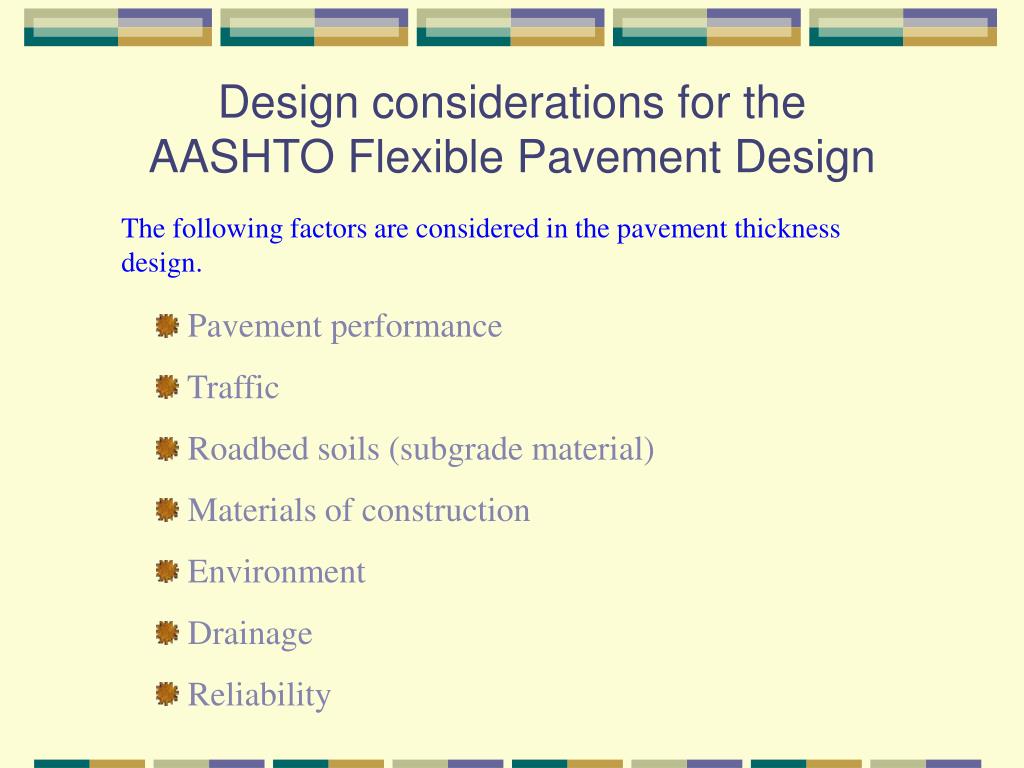

It can also be used to perform loss of support analysis and load transfer efficiency (LTE) calculations. Structure III is an example of a heavily loaded highway pavement. The tool is capable of analyzing raw deflection data files obtained from Falling Weight Deflectometer (FWD) testing devices, backcalculating in-place elastic layer moduli for flexible and rigid pavements and generating inputs for performing rehabilitation design using Pavement ME.

#Flexible pavement design aashto example software
The Pavement ME Deflection Data Analysis and Backcalculation Tools is a standalone software program that can be used to generate backcalculation inputs to the AASHTO Pavement ME Design software for rehabilitation design. It also supplies some basic information on variable descriptions, typical values and equation precautions. This design utility solves the 1993 AASHTO Guide basic design equation for flexible pavements. Check to see that the computed SN value is reasonably close to that assumed for ESAL calculations. ME Design is a production-ready software tool to support the day-to-day pavement design functions of public and private pavement engineers. Determine and gather flexible pavement design inputs (Z R, S o, PSI and M R).
#Flexible pavement design aashto example manual
ME Design supports AASHTO"s Mechanistic-Empirical Pavement Design Guide, Interim Edition: A Manual of Practice. 8f M101.18u Topic 7 AASHTO Flexible Pavement Design. ***ĪASHTOWare Pavement ME Design is the next generation of AASHTOWare® pavement design software, which builds upon the mechanistic-empirical pavement design guide, and expands and improves the features in the accompanying prototype computational software. 2.4.1 Effective Subgrade Resilient Modulus (cont) 2.32R. Design Methods Highway Pavements AASHTO The Asphalt Institute Portland Cement Association Airfield Pavements FAA. ***AASHTOWare Backcalculation Tools v1.1.6 is now available. distress prediction models for flexible pavements include: total rutting.

***AASHTOWare Pavement ME Design v2.6.2.1 is now available. empirical pavement design guide (MEPDG) and the release of AASHTOWare. Effective modulus of subgrade reaction (considering the composite effect of base and subgrade): 200 pci Effective subgrade resilient modulus: 13,000 psi Design reliability: 95% Overall standard deviation (S o ): 0.45 Drainage coefficient (C d ): 1.0 Load transfer coefficient: 3.2 (dowel bars with asphalt shoulder) PCC modulus Ec = 4,000,000 psi PCC modulus of rupture S'c = 635 psi Design a typical flexible pavement structure following the 1993 AASHTO Guide for Design of Pavement Structures (Note: for flexible pavement, you need to determine the type of material and thickness of each layer above the roadbed soil).Email is required. Use the COPES equation below to calculate Lane Factor (L F ), assuming it remains constant across the pavement design life: The initial serviceability index is 4.2 for both flexible and rigid pavements, and the terminal serviceability index is 2.5 for both pavements. Percent trucks during a 24 hour period, T 24, is 8% The truck traffic annual compound growth rate is 3%. Example of Flexible Pavement Design following AASHTO 1993 Pavement Design Guide For a highway with two lanes in each travel direction and the following data The design life is 20 years for a flexible pavement The first year two-way AADT is 38000 Traffic directional distributional factor, D F, is 0.5 (i.e., 50% AADT in one direction) The Truck Factor (i.e., number of ESALs per truck), E 18, is 1.05 for flexible pavement.


 0 kommentar(er)
0 kommentar(er)
